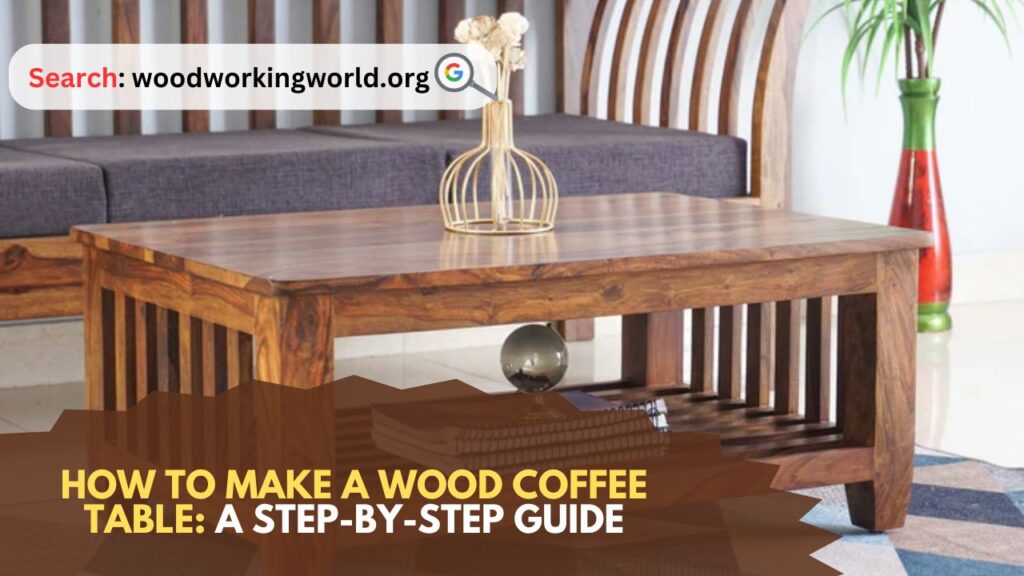Wood Coffee Table: A wood coffee table is not just a piece of furniture; it’s a central element that can bring warmth and character to your living space. Crafting your own wood coffee table allows you to create a unique piece that perfectly fits your style and needs. Whether you are a seasoned woodworker or a beginner looking to start a new project, this guide will take you through the steps of making a beautiful and functional wood coffee table.

How to Make a Wood Coffee Table
Materials and Tools You’ll Need
Materials:
- Hardwood boards (oak, walnut, or maple are great choices)
- Wood glue
- Screws
- Wood stain or finish
- Sandpaper (various grits)
- Wood filler (optional)
- Paint or sealant (optional)
Tools:
- Tape measure
- Circular saw or table saw
- Miter saw
- Drill and bits
- Clamps
- Sander or sanding block
- Paintbrushes or rags for staining
- Safety gear (gloves, goggles, mask)
Step 1: Planning and Design
Before you begin cutting wood, it’s essential to plan and design your coffee table. Consider the following:
- Size: Standard coffee tables are typically 16-18 inches tall and around 48 inches long and 24 inches wide, but you can adjust the dimensions based on your needs.
- Style: Decide on the style you want, whether it’s rustic, modern, or traditional.
- Materials: Choose the type of wood and finish that will complement your living space.
Sketch your design, noting the dimensions and the placement of the legs, supports, and tabletop. This blueprint will serve as your guide throughout the project.
Step 2: Cutting the Wood
Once you have your design ready, it’s time to cut the wood to size. Use the tape measure and saw to make precise cuts according to your blueprint. Here are the general pieces you will need:
- Tabletop: Four or five boards cut to your desired length and width.
- Legs: Four pieces cut to the desired height of your table.
- Aprons: These are the pieces that connect the legs to the tabletop. Cut four pieces to the length and width of the table minus the thickness of the legs.
Tips for Cutting:
- Always measure twice and cut once to ensure accuracy.
- Use a miter saw for angled cuts to ensure clean edges.
Step 3: Assembling the Tabletop
Lay the boards for the tabletop on a flat surface, arranging them in the desired order. Apply wood glue along the edges where the boards meet and clamp them together. Make sure the surface is flat and the boards are aligned properly. Let the glue dry according to the manufacturer’s instructions.
Tips for Assembly:
- Use clamps to hold the boards together while the glue dries to prevent gaps.
- Wipe away any excess glue with a damp cloth before it dries.
Step 4: Building the Base
While the tabletop glue is drying, you can start building the base. Attach the aprons to the legs using wood glue and screws. Drill pilot holes to prevent the wood from splitting and ensure the screws go in smoothly.
Tips for Building the Base:
- Use corner braces for additional stability.
- Ensure the legs are square to the aprons to keep the table level.
Step 5: Attaching the Tabletop to the Base
Once the tabletop is dry and sanded smooth, it’s time to attach it to the base. Place the tabletop upside down on a flat surface and position the base on top of it. Use wood screws to secure the aprons to the tabletop from underneath. Be sure to drill pilot holes to avoid splitting the wood.
Tips for Attaching:
- Make sure the tabletop overhang is even on all sides.
- Use clamps to hold the base in place while you attach it.
Step 6: Sanding and Finishing
With the table assembled, the next step is to sand it down to a smooth finish. Start with a coarse grit sandpaper (around 80 grit) and gradually work up to a finer grit (220 grit). Sand the entire table, paying special attention to any rough edges or surfaces.
Tips for Sanding:
- Always sand with the grain of the wood to avoid scratches.
- Wear a mask to avoid inhaling dust.
After sanding, you can apply a wood stain or finish to protect the wood and enhance its appearance. Choose a stain that complements your decor and apply it evenly with a brush or cloth. Allow the stain to dry, then apply a clear sealant to protect the surface.
Tips for Staining and Finishing:
- Test the stain on a scrap piece of wood first to ensure you like the color.
- Apply multiple thin coats rather than one thick coat for a smoother finish.
Step 7: Final Touches
After the finish has dried, inspect your table for any imperfections. Use wood filler to fill any gaps or holes, sand it smooth, and apply a final coat of sealant if necessary.
Tips for Final Touches:
- Attach felt pads to the bottom of the legs to protect your floors.
- Consider adding decorative elements like metal brackets or a lower shelf for additional functionality.
Enjoy Your New Coffee Table
Congratulations! You’ve made your own wood coffee table. This handcrafted piece will not only serve as a functional part of your living room but also as a testament to your woodworking skills. Enjoy the satisfaction of creating a beautiful and useful piece of furniture with your own hands.
Maintenance Tips:
- Regularly dust and clean your table with a soft cloth.
- Avoid placing hot or wet items directly on the wood to prevent damage.
- Reapply a wood finish or sealant every few years to keep the table looking its best.
Conclusion: Wood Coffee Table
Making a wood coffee table is a rewarding project that combines creativity, skill, and practicality. By following these steps, you can create a custom piece that adds character and charm to your home. Whether you’re a beginner or an experienced woodworker, this guide provides the foundation for crafting a beautiful coffee table that will be a centerpiece in your living room for years to come.
Remember, woodworking is a journey of learning and improvement. Each project you undertake helps you refine your skills and techniques. So, don’t be afraid to experiment with different designs and finishes to make each piece uniquely yours. Happy woodworking!
I hope this article on Wood Coffee Table has been helpful. If you have any further questions, please feel free to leave a comment below.
Video
